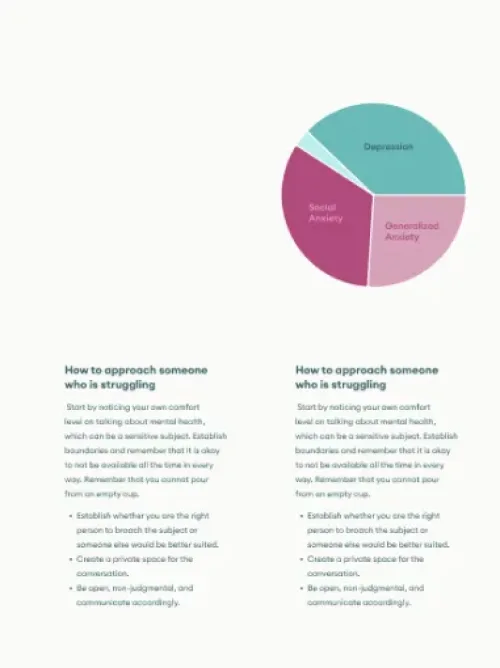10 Metrics You Need to Be Tracking in Your Workplace Mental Health Program

5 Minute Read
Here are the top 10 metrics you need to be tracking to measure the success of your workplace mental health program.
1 -Utilization & Program Uptake
Utilization refers to the percentage of employees that have accessed your service from your overall organization. Program uptake on the other hand, is a summary of program participation during a specific reporting period. Comparisons of uptake quarter over quarter can enable organizations to review how the program is being adopted. It can also show the effects of certain external events on employee mental health needs and challenges. Seeing an uptick after a challenging event can give employers the confidence that employees are getting the help they need.
Benefits professionals seek a robust benefits program that people use, but also need to control costs and stick to the budget. Therein lies the decision on what your mental health program should look like for you. Measuring utilization and program uptake can enable an organization to review overall program health.
2-Change in Absenteeism & Disability Costs
Looking at absenteeism and disability costs associated with your organization before and after the adoption of a workplace mental health program, and tracking the changes over time, enables an organization to gauge the success of a program. It also provides the means the understand the return on investment. While adding another mental health solution may look like an added cost, decrease in disability claims and prevention of loss of productivity can outweigh the initial investment and help the organization perform better over time.
According to Mental Health Commission of Canada(MHCC)1 ,”Mental health problems and illnesses account for approximately 30% of short – and long-term disability claims and are rated one of the top three drivers of such claims by more than 80% of Canadian employers.” Moreover, “Improved management of mental health in the workplace including prevention, early action to combat stress and identify problems could decrease losses to productivity significantly.”
3- Employee Satisfaction
Employee satisfaction is measured through surveys that look at quantifying the outcomes of a workplace mental health program. These surveys will usually consider the coping mechanisms and skills developed, the helpfulness of content, overall support received, and the overall experience.
A program cannot be successful without executive and end-user buy-in. Calculating employee satisfaction will not only provide insights into HR teams on overall satisfaction and feedback but will also arm the HR teams in proving to leadership with the means to prove that the program is working and well-liked.
4- Availability of Communications & Sustained Awareness
Every new service and program added to a firm has a change management aspect to it as new program adoption is related to change in employee behavior. According to Harvard Business Review: “Change communications is never a one-and-done event; keeping employees informed is something that you will have to do throughout every step of the change process. Studies have found that continual communication is a leading factor in a transformation’s success.”
Evaluating the cadence of workplace mental health programs and comparing program utilization metrics with the cadence in communications have continuously proven that sustained awareness within a firm ensures program success.
5-Time to Service
This metric looks at the time from when the employee first accesses the program to request help to when they receive mental health services.
Due to the high demand for mental health programs versus the availability of mental healthcare professionals, all Canadian providers are currently struggling to keep wait times below a certain level. When comparing services, it is important to look at the overall industry benchmarks versus single providers. The average wait times in the industry is currently 2-4 weeks or more.
6- Demographics
This is usually estimated by the summary of participant demographics of those who submitted any assessments, and can include age, gender, language and more. Demographics of program users can inform employers on who is accessing the mental health programs the most. It can also show who isn’t. Having access to this information can enable targeted approaches to destigmatizing mental health for certain groups through enhancements to inclusivity, protection of privacy, increased education as well as normalizing mental health challenges.
According to the Centre for Mental Health and Addictions(CMHA)2, “higher rates of depression, anxiety, obsessive-compulsive and phobic disorders, suicidality, self-harm, and substance use” are observed among LGBT people. Moreover, the MHCC3 has made a case for improving mental health services to people from diverse backgrounds. In a time when diversity, equity and inclusion are more important than ever, it is important to make sure all employees can get the help they need.
7- Primary Health Concern
This is an indicator for what primary concerns employees have when seeking mental health support. This again, is an indicator that can help employers become better leaders by gauging the needs of employees. It can also in turn help support employees better. Is a certain team exhibiting significantly higher anxiety levels compared to another group within the org? It may be time to reassess the work conditions for that group to ensure overall employee satisfaction to prevent absenteeism, turnover and burnouts. It is also a great pulse check for the overall organization.
8- Symptom Severity Before and After Treatment
Quantifying the effectiveness of mental health therapies can be one of the biggest determinants of therapy effectiveness. MindBeacon looks at the severity of symptoms across programs and classifies them from subclinical to severe and compares the initial status of participants with the outcomes after the completion of programs. This data, when provided to employers can be proof that the program is working and can help with getting buy-in from leadership to continue a larger commitment to mental health.
9- Mental Health Improvement
Mental health improvement is overall data on experienced improvement and clinical improvement observed among employees. MindBeacon adds a second layer to this data through a comparison of the mental health improvement of participants within the firm to overall MindBeacon users. This way, there is a quantifiable outcome on the effectiveness of the programs.
10- Benchmarking
Data on its own may not mean anything. Benchmarking provides the opportunity to compare metrics with other users getting the same service, so you can simply compare apples to apples. MindBeacon, with it’s quarterly State of Workplace Mental Health in Canada report enables employers to understand the current and changing landscape of mental health at workplaces and provides the means to compare data with others.
If you’re looking to enhance your workplace wellness support, reach out to us here. We can offer best practices and recommendations to support you with employee attraction, retention and wellness benefits among others.




